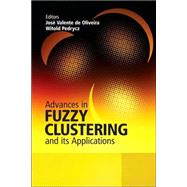
Note: Supplemental materials are not guaranteed with Rental or Used book purchases.
Purchase Benefits
What is included with this book?
Witold Pedrycz is a Professor and Canada Research Chair (CRC) in the Department of Electrical and Computer Engineering, University of Alberta, Edmonton, Canada. He is also with the Systems Research Institute of the Polish Academy of Sciences. He is actively pursuing research in computational intelligence, fuzzy modeling, knowledge discovery and data mining, fuzzy control including fuzzy controllers, pattern recognition, knowledge-based neural networks, relational computation, bioinformatics, and Software Engineering. He currently serves as an Associate Editor of IEEE Transactions on Fuzzy Systems.
| List of Contributors | |
| Foreword | |
| Preface | |
| Fundamentals | |
| Fundamentals of Fuzzy Clustering | |
| Introduction | |
| Basic Clustering Algorithms | |
| Distance Function Variants | |
| Objective Function Variants | |
| Update Equation Variants: Alternating Cluster Estimation | |
| Concluding Remarks | |
| Acknowledgements | |
| References | |
| Relational Fuzzy Clustering | |
| Introduction | |
| Object and Relational Data | |
| Object Data Clustering Models | |
| Relational Clustering | |
| Relational Clustering with Non-spherical Prototypes | |
| Relational Data Interpreted as Object Data | |
| Summary | |
| Experiments | |
| Conclusions | |
| References | |
| Fuzzy Clustering with Minkowski Distance Functions | |
| Introduction | |
| Formalization | |
| The Majorizing Algorithm for Fuzzy C-means with Minkowski Distances | |
| The Effects of the Robustness Parameter | |
| Internet Attitudes | |
| Conclusions | |
| References | |
| Soft Cluster Ensembles | |
| Introduction | |
| Cluster Ensembles | |
| Soft Cluster Ensembles | |
| Experimental Setup | |
| Soft vs. Hard Cluster Ensembles | |
| Conclusions and Future Work | |
| Acknowledgements | |
| References | |
| Visualization | |
| Aggregation and Visualization of Fuzzy Clusters Based on Fuzzy Similarity Measures | |
| 5.1 | |
| 5.2 | |
| 5.3 | |
| 5.4 | |
| 5.5 | |
| Validity Indices | |
| The Modified Sammon Mapping Algorithm | |
| Acknowledgements | |
| References | |
| Interactive Exploration of Fuzzy Clusters | |
| Introduction | |
| Neighborgram Clustering | |
| Interactive Exploration | |
| Parallel Universes | |
| Discussion | |
| References | |
| Algorithms and Computational Aspects | |
| Fuzzy Clustering with Participatory Learning and Applications | |
| Introduction | |
| Participatory Learning | |
| Participatory Learning in Fuzzy Clustering | |
| Experimental Results | |
| Applications | |
| Conclusions.Acknowledgements | |
| References | |
| Fuzzy Clustering of Fuzzy Data | |
| Introduction | |
| Informational Paradigm, Fuzziness and Complexity in Clustering Processes | |
| Fuzzy Data | |
| Fuzzy Clustering of Fuzzy Data | |
| An Extension: Fuzzy Clustering Models for Fuzzy Data Time Arrays | |
| Applicative Examples | |
| Concluding Remarks and Future Perspectives | |
| References | |
| Inclusion-based Fuzzy Clustering | |
| Introduction | |
| Background: Fuzzy Clustering | |
| Construction of an Inclusion Index | |
| Inclusion-based Fuzzy Clustering | |
| Numerical Examples and Illustrations | |
| Conclusions | |
| Acknowledgements | |
| References | |
| Mining Diagnostic Rules Using Fuzzy Clustering | |
| Introduction | |
| Fuzzy Medical Diagnosis | |
| Interpretability in Fuzzy Medical Diagnosis | |
| A Framework for Mining Interpretable Diagnostic Rules | |
| An Illustrative Example | |
| Concluding Remarks | |
| References | |
| Fuzzy Regression Clustering | |
| Introduction | |
| Statistical Weighted Regression Models | |
| Fuzzy Regression Clustering Models | |
| Analyses of Residuals on Fuzzy Regression Clustering Models | |
| Numerical Examples | |
| Conclusion | |
| References | |
| Implementing Hierarchical Fuzzy Clustering in Fuzzy Modeling Using the Weighted | |
| Table of Contents provided by Publisher. All Rights Reserved. |
The New copy of this book will include any supplemental materials advertised. Please check the title of the book to determine if it should include any access cards, study guides, lab manuals, CDs, etc.
The Used, Rental and eBook copies of this book are not guaranteed to include any supplemental materials. Typically, only the book itself is included. This is true even if the title states it includes any access cards, study guides, lab manuals, CDs, etc.